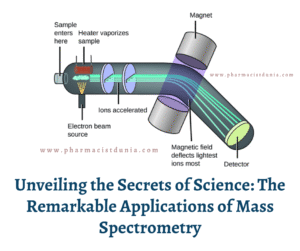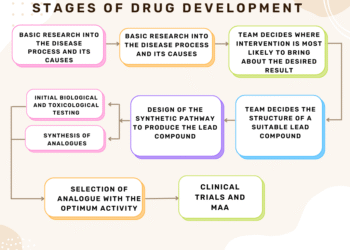Discover the diverse applications of mass spectrometry in science. From isotope dating and tracking to environmental analysis and protein characterization, explore how mass spectrometry revolutionizes research in various fields. Learn more about this powerful analytical technique and its contributions to advancements in medicine, environmental monitoring, forensics, and more!
Unveiling the Secrets of Science: The Remarkable Applications of Mass Spectrometry
Step into the world of mass spectrometry, a cutting-edge analytical technique that unlocks a myriad of scientific possibilities. From unraveling the mysteries of ancient artifacts to advancing personalized medicine, mass spectrometry has become an indispensable tool across diverse fields. Join us on a journey as we explore the remarkable applications of mass spectrometry, delving into isotope dating, protein characterization, environmental analysis, forensics, and beyond. Prepare to be captivated by the immense power and endless potential of this groundbreaking technology.
Mass spectrometry, a powerful analytical technique, finds diverse applications in various scientific fields. Here are several areas where mass spectrometry is extensively utilized:
1. Isotope Ratio Mass Spectrometry (Isotope Dating and Tracking):
Mass spectrometry is widely employed to determine the isotopic composition of elements within a sample. This technique enables researchers to measure the abundance of different isotopes and use them for dating geological materials, such as rocks and fossils. Additionally, it is valuable in tracking isotopic markers to study ecological and environmental processes, such as nutrient cycling, migration patterns, and food web dynamics.
2. Trace Gas Analysis:
Mass spectrometry plays a crucial role in trace gas analysis, which involves the detection and quantification of extremely low concentrations of gases in various samples. By ionizing and separating gas molecules based on their mass-to-charge ratios, mass spectrometers can identify and measure trace gases present in complex matrices. This application finds applications in environmental monitoring, atmospheric science, forensic investigations, and industrial process control.
3. Atom Probe:
An atom probe is a specialized instrument that combines time-of-flight mass spectrometry with field ion microscopy (FIM). It allows for the precise mapping of individual atoms within a material. By applying high electric fields, atoms are field-ionized from the sample surface, and their mass-to-charge ratios are measured using mass spectrometry. This technique enables researchers to study the atomic-scale composition and structure of materials, contributing to advancements in materials science and nanotechnology.
4. Pharmacokinetics:
Mass spectrometry is widely utilized in pharmacokinetic studies, which involve the analysis of drug metabolism, distribution, and elimination in the body. Due to the complex nature of biological matrices like blood or urine and the need for high sensitivity, mass spectrometry offers an ideal solution. It allows researchers to detect and quantify drugs and their metabolites at low doses and over extended periods, providing valuable insights into drug efficacy, dosage optimization, and patient safety.
5. Protein Characterization:
Mass spectrometry has emerged as a crucial method for protein characterization and sequencing. By ionizing and fragmenting proteins, mass spectrometers can determine their molecular weights, identify post-translational modifications, and provide structural information. This information is vital for understanding protein function, protein-protein interactions, and disease mechanisms. Mass spectrometry-based proteomics has revolutionized the field of biology and enabled significant advancements in personalized medicine.
6. Glycan Analysis:
Mass spectrometry (MS) has become the predominant technique in glycobiology for the characterization and elucidation of glycan structures. With its low sample requirement and high sensitivity, MS allows for the analysis of complex carbohydrate molecules. It aids in identifying glycan composition, linkage patterns, and modifications, contributing to our understanding of their roles in various biological processes, such as cell signaling, immune responses, and disease pathology.
7. Space Exploration:
Mass spectrometers have become a standard method for chemical analysis in space exploration missions. They have been utilized to investigate the composition of planetary atmospheres, study the presence of organic compounds, and identify elements and isotopes on other planets and moons. Mass spectrometry provides critical data for understanding the geology, chemistry, and potential habitability of celestial bodies, contributing to our knowledge of the universe.
8. Respired Gas Monitoring:
Starting around 1975, mass spectrometers were employed in hospitals for respiratory gas analysis. This application involves analyzing the composition of exhaled breath to monitor respiratory conditions and metabolic disorders. Mass spectrometry enables the detection and measurement of various gases, including carbon dioxide, oxygen, nitrogen, and volatile organic compounds, providing valuable insights into lung function, gas exchange, and metabolic processes.
9. Environmental Analysis:
Mass spectrometry is extensively used in environmental analysis to identify and quantify pollutants, contaminants, and toxic substances in air, water, soil, and biological samples. It enables the detection of organic and inorganic compounds, including pesticides, industrial chemicals, heavy metals, and persistent organic pollutants. This application aids in environmental monitoring, risk assessment, and the development of remediation strategies.
10. Forensic Science:
Mass spectrometry plays a vital role in forensic science by providing accurate and sensitive analysis of forensic samples. It is used for the identification of drugs, explosives, toxins, and other chemical substances encountered in criminal investigations. Mass spectrometry can also assist in analyzing trace evidence, such as fibers, paint, and glass fragments, aiding in the determination of their origin and contributing to the reconstruction of crime scenes.
11. Metabolomics:
Metabolomics, the comprehensive analysis of small molecules present in biological systems, heavily relies on mass spectrometry. By analyzing the metabolite profile of biological samples, such as blood, urine, and tissues, mass spectrometry helps in understanding metabolic pathways, identifying biomarkers of diseases, and assessing the impact of drugs or environmental factors on metabolism. Metabolomics has applications in personalized medicine, nutrition, and biomedical research.
12. Food and Beverage Analysis:
Mass spectrometry is used in the analysis of food and beverages to ensure their safety, quality, and authenticity. It can detect and quantify contaminants, such as pesticides, mycotoxins, and food allergens, as well as assess the composition and quality of food products. Mass spectrometry is also employed in the authentication of food products, including the detection of adulteration and the determination of the geographical origin or authenticity of ingredients.
13. Petrochemical Analysis:
Mass spectrometry plays a crucial role in the analysis of petroleum products and petrochemicals. It enables the identification and quantification of hydrocarbons, sulfur compounds, heavy metals, and other components present in crude oil, gasoline, diesel, and lubricants. Mass spectrometry is used in refining processes, quality control, and environmental monitoring related to the petrochemical industry.
14. Metallomics:
Metallomics involves the study of metal ions in biological systems and their roles in various biological processes. Mass spectrometry allows for the analysis of metal-protein interactions, metalloprotein identification, and quantification of metal ions in biological samples. This field of research contributes to our understanding of metal homeostasis, metal-based diseases, and the development of metal-based therapeutics.
15. Environmental Forensics:
Mass spectrometry is employed in environmental forensics to identify and trace the sources of pollutants and contaminants in the environment. By analyzing stable isotopes, elemental composition, and molecular markers, mass spectrometry assists in determining the origin and transport pathways of pollutants, providing crucial information for environmental remediation and legal investigations.
These are just a few examples of the broad range of applications for mass spectrometry. The versatility and sensitivity of this technique make it an indispensable tool across numerous scientific disciplines, contributing to advancements in research, industry, and public health.
In conclusion, the applications of mass spectrometry are vast and far-reaching, revolutionizing scientific research across numerous disciplines. From determining the age of ancient artifacts through isotope dating to unlocking the mysteries of protein structures and identifying pollutants in our environment, mass spectrometry has become an indispensable tool for scientists and researchers.
The versatility and sensitivity of mass spectrometry have allowed for breakthroughs in fields such as pharmacokinetics, proteomics, space exploration, and forensic science. It has enabled us to delve into the intricacies of molecular structures, track isotopic markers, analyze complex mixtures, and gain invaluable insights into the world around us.
As technology continues to advance, so too will the capabilities of mass spectrometry. It will play a crucial role in future scientific discoveries, helping us understand our universe, develop new medications, safeguard our environment, and unlock the secrets of life itself.
So, let us continue to explore, innovate, and harness the power of mass spectrometry as we strive toward new frontiers of knowledge and continue to unravel the complexities of the world we inhabit.












